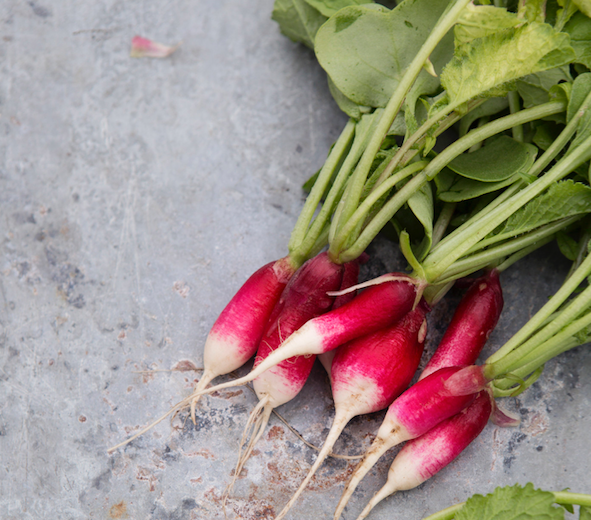
We love spring for many reasons, but mainly because so many of our favorite fruits and vegetables are in season. One of those favorites? Radishes. The colorful, crisp root vegetables add beautiful heat and dimension to any dish, yet there is so little we actually know about them. Why are they spicy? Is there any way to tell how spicy they are before we bite into them? Why are they so good for us?
To answer these questions, we decided to consult a few experts. Here's what we learned:
So, does the size of a radish affect its spice level?
According to David Wees, a professor in the Department of Plant Science at McGill University, size doesn't necessarily play a role. "The flavors (or 'pungency,' in scientific terms) in radishes are mainly due to a group of sulphur-containing compounds called isothiocyanates," explained Mr. Wees. "The more isothiocyanates in a radish, the hotter it tastes."
OK, so what affects isothiocyanate concentration in a radish?
"Many things, [like] the variety of radish chosen, the temperature at which the radishes are grown, etc. The size alone of the radish does not necessarily affect how 'hot' a radish is but the age of the radish can. Generally speaking, if you wait to dig your radishes from your garden for a few extra weeks, the radishes develop more isothiocyanates and therefore get 'hotter.' Also, radishes grown in hot weather (e.g. in mid-summer) tend to be spicier than those grown in cool weather (for example in the fall)."
Why are radishes good for us?
To find this out, we asked Dr. Mark Lubkowitz, Professor of Biology at Saint Michael's College. "Many of us love eating spicy plants like wasabi, radishes, and mustards which produce that desirable burn in our sinuses and back of our head. Isothiocyanates [are] the culprit and are quite good for us since they help protect our DNA and lower our risk for cancer." According to the Physicians Committee for Responsible Medicine, isothiocyanates are so good for us because they "don't allow carcinogens to be activated ... they counteract the poisonous effects of carcinogens that have been activated and they speed up their removal from the body."
So why do radishes produce isothiocyanates in the first place?
"Plants like radishes that produce these compounds make them for protection -- they help keep fungi and herbivores away," Dr. Lubkowitz explained. "The root of the radish is like a savings account filled with sugars made by the plant all summer long. Like any savings account it needs to be guarded and so the plant guards it chemically with isothiocyanates."
Which varieties are hottest?
Every variety has its own properties but the hottest is known to be the Black Spanish. French Breakfast is known to be one of the mildest types, and the common grocery store Cherry Belle variety is somewhere in the middle.
So there you have it. Eat up!